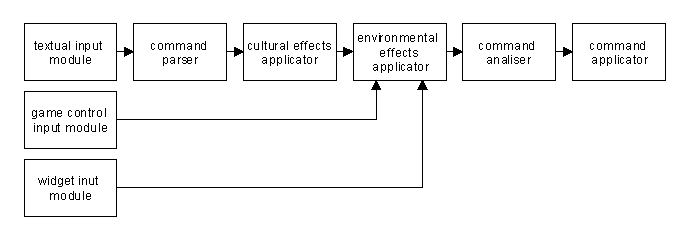The purpose of the command processor is to take away the specific binding between input via the user interface and agents by placing an interpretive layer in the process. The processor converts the commands to the internal command representation and adds any special effects.
see also: command object model
The input command processor takes input from the screen and processes these actions on the game.
Because of latency in the network, the processor uses the optimistic processing paradigm when it comes to multi-user record locks.

For example:
- The textual input module takes the input input through the GUI.
- The command parser analyses the lexical input for lexical objects.
- The cultural effects applicator converts the objects to their core internal representation.
- The environmental effects applicator makes any necessary modifications to the requested action.
- The command analyser converts the command into a set of internal object instructions.
- The command applicator applies the command to the game core.
The game control input module is a control set for devices such as joysticks.
The widget input module is a set of control input modules for windows widgets such as menus, buttons and slider controls.
Object Links
- Command analyser
- Command applicator
- Command parser
- Cultural effects applicator
- Environmental effects applicator
- Game control input module
- Textual input module
- Widget input module
Need to add
- Emotional State applicator
- Physical State applicator
22/11/99